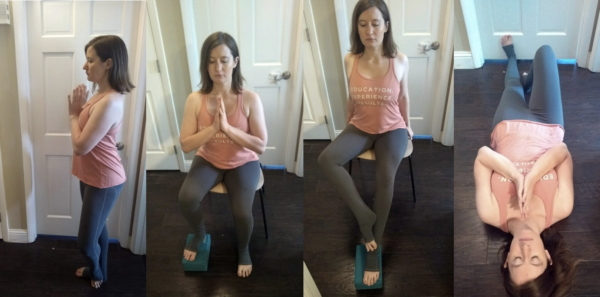Articles, In the Press, Mental Health, Resources, Teacher Training
Yoga for Every Body: Supporting Students with Disabilities
By Jaci Gandenberger for Yoga Medicine®.

The first time I offered a group yoga class to people with disabilities, only one student showed up. She was an experienced yogi who had fractured her elbow, so we focused on standing poses followed by restorative shapes to soothe her nervous system. After class, she said that it was the first time her nerves had stopped jangling since her injury and that she looked forward to coming back.
Great! I thought. Next week, I’ll create a sequence that’s designed to support her.
The following week, she didn’t attend. Instead, she was replaced by a student who had never practiced yoga and who used a wheelchair. Needless to say, that lovingly designed sequence had to be tossed out the window.
Every experienced vinyasa yoga teacher has stories of creating sequences that were completely wrong for the students who came to class, but when teaching adaptive yoga, the challenges can be more dramatic. I’ve also found these classes to be some of the richest, most enjoyable, and engaging that I’ve taught, and they’ve made me a better teacher in my able-bodied classes too.
Here are a few of the most important lessons I’ve learned:
1) Be aware of your own ableism.
This can range from careless language choices (I still cringe at the time I thoughtlessly described myself as “spazzy” in one of my classes), to deeply rooted and perhaps unexamined assumptions. For example, not everyone who uses a wheelchair sees that as a burden or has the goal of one day getting out of their chair. Take the time to really listen to your students and learn what their goals are, rather than setting out to “fix” them according to your own values and priorities.
2) Consider the purpose of each pose.
As you create a class – whether by planning it in advance or developing it in the moment – take time to reflect on your true goal with each shape. Take tree pose, for example. Your primary goal with the shape could be grounding, a gentle hip opening, increasing core strength, building the stabilizing muscles of the ankle and foot, teaching about drishti, or something else entirely. Once you know your true goal, you’ll have a much better sense of how to adapt the pose for a wide variety of bodies.

Tree pose can be done with the foot as a kickstand, using the wall for support, from a chair, with a block to support the shape, or even on the floor, pressing into a wall for grounding.
3) Take your time.
Many people with disabilities are expected to spend most of their lives adapting to the able-bodied world. That often includes having other people move their bodies for them. In my experience, many disabled students savor the opportunity to take a class that moves at their pace. Sometimes that means me giving five minutes for a student to move themselves from their chair to the floor, or collaborating with them to find a prop set-up that will allow them to settle into a pose rather than being expected to skip past it. Don’t be afraid to converse with your students so that they have space to tell you how you can best support them.
4) Move through the joints.
Feeling overwhelmed about where to start? One structure that I’ve found helpful is to move through the major joints of the body, starting at either the top or the bottom. So, I might start class with neck releases, then shoulder circles, then moving the spine through its major movements (forward bending, back bending, side bending, and twists). Next would come elbow, wrist, and finger movements, then hip releases, followed by knee, ankle, and toe movements. If you move slowly and mindfully through the class, and take time to make each shape work for each student (which might include them physically manipulating parts of their bodies, such as using their hands to move their legs through hip circles), this is often a sufficient physical practice. If you add in a bit of breathwork and some restorative shapes and savasana, this work can comfortably fill a 60-90 minute class.
If you want to learn more about how to teach students with disabilities, one great resource is Accessible Yoga. They offer trainings around the country, an annual conference, an educational blog, and an online community that is readily available to answer questions and offer fresh perspectives.












